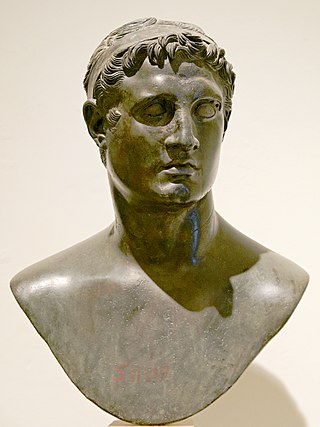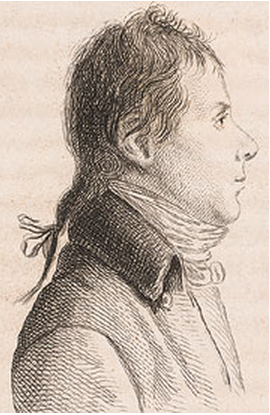
The Ptolemaic dynasty, sometimes referred to as the Lagid dynasty, was a Macedonian Greek royal dynasty which ruled the Ptolemaic Kingdom in Ancient Egypt during the Hellenistic period. Their rule lasted for 275 years, from 305 to 30 BC. The Ptolemaic was the last dynasty of ancient Egypt.

The Red Sea is a seawater inlet of the Indian Ocean, lying between Africa and Asia. Its connection to the ocean is in the south, through the Bab el Mandeb strait and the Gulf of Aden. To its north lie the Sinai Peninsula, the Gulf of Aqaba, and the Gulf of Suez. It is underlain by the Red Sea Rift, which is part of the Great Rift Valley.

The Suez Canal is an artificial sea-level waterway in Egypt, connecting the Mediterranean Sea to the Red Sea through the Isthmus of Suez and dividing Africa and Asia. The 193.30 km (120.11 mi) long canal is a popular trade route between Europe and Asia.

Necho II of Egypt was a king of the 26th Dynasty, which ruled from Sais. Necho undertook a number of construction projects across his kingdom. In his reign, according to the Greek historian Herodotus, Necho II sent out an expedition of Phoenicians, which in three years sailed from the Red Sea around Africa to the Strait of Gibraltar and back to Egypt. His son, Psammetichus II, upon succession may have removed Necho's name from monuments.

Ptolemy II Philadelphus, also known posthumously as Ptolemy the Great, was the pharaoh of Ptolemaic Egypt from 284 to 246 BC. He was the son of Ptolemy I, the Macedonian Greek general of Alexander the Great who founded the Ptolemaic Kingdom after the death of Alexander, and Queen Berenice I, originally from Macedon in northern Greece.

Berenice I was Queen of Egypt by marriage to Ptolemy I Soter. She became the second queen, after Eurydice, of the Ptolemaic dynasty of Egypt.

Lower Egypt is the northernmost region of Egypt, which consists of the fertile Nile Delta between Upper Egypt and the Mediterranean Sea, from El Aiyat, south of modern-day Cairo, and Dahshur. Historically, the Nile River split into seven branches of the delta in Lower Egypt.
Cats were represented in social and religious practices of ancient Egypt for more than 3,000 years. Several ancient Egyptian deities were depicted and sculptured with cat-like heads such as Mafdet, Bastet and Sekhmet, representing justice, fertility and power. The deity Mut was also depicted as a cat and in the company of a cat.
Qift is a small town in the Qena Governorate of Egypt about 43 km (27 mi) north of Luxor, situated under 26° north lat., on the east bank of the Nile. In ancient times its proximity to the Red Sea made it an important trading emporium between India, Punt, Felix Arabia and the North. It was important for nearby gold and quartzite mines in the Eastern Desert, and as a starting point for expeditions to Punt.
Arsinoe or Arsinoites or Cleopatris or Cleopatra, was an ancient city at the northern extremity of the Heroopolite Gulf, in the Red Sea.
Zenon or Zeno, son of Agreophon, was a public official in Ptolemaic Egypt around the 250s-230s BC. His writings are known from a cache of papyrus documents which was discovered by archaeologists in the Nile Valley in 1914.
Olbia or Arsinoe was an ancient city in the Regio Troglodytica upon the western coast of the Red Sea between Philoteras and Myos Hormos.. The city was renamed from Olbia to Arsinoe by Ptolemy II in honor of Arsinoe II of Egypt, who was both his sister and wife. According to Agatharchides, there were hot springs in its neighborhood. The city stood nearly at the point where the limestone range of the Arabian hills joins the Mons Porphyrites, and at the southern entrance of the Gulf of Suez.

The Canal of the Pharaohs, also called the Ancient Suez Canal or Necho's Canal, is the forerunner of the Suez Canal, constructed in ancient times and kept in use, with intermissions, until being closed for good in 767 AD for strategic reasons during a rebellion. It followed a different course from its modern counterpart, by linking the Nile to the Red Sea via the Wadi Tumilat. Work began under the pharaohs. According to Darius the Great's Suez Inscriptions and Herodotus, the first opening of the canal was under Persian king Darius the Great, but later ancient authors like Aristotle, Strabo, and Pliny the Elder claim that he failed to complete the work. Another possibility is that it was finished in the Ptolemaic period under Ptolemy II, when engineers solved the problem of overcoming the difference in height through canal locks.

Wadi Tumilat is the 50-kilometre-long (31 mi) dry river valley (wadi) to the east of the Nile Delta. In prehistory, it was a distributary of the Nile. It starts near the modern town of Zagazig and the ancient town of Bubastis and goes east to the area of modern Ismaïlia.

Jacques-Marie Le Père was a French civil engineer.
The Société d'études du Canal de Suez was a society set up in 1846 by the Saint-Simonist Prosper Enfantin in Paris to study the Isthmus of Suez and the possibility of a Suez Canal.
Ancient Egyptian trade consisted of the gradual creation of land and sea trade routes connecting the ancient Egyptian civilization with ancient India, the Fertile Crescent, Arabia and Sub-Saharan Africa.
Jean Clédat was a French Egyptologist, archaeologist and philologist. He became a resident at the Institut Français d'Archéologie Orientale. At various times, Clédat's expeditions was sponsored by Compagnie universelle du canal maritime de Suez, the Supreme Council of Antiquities, the Comité, and the Institut itself.
Wadi al-Jarf is an area on the Red Sea coast of Egypt, 119 km (74 mi) south of Suez, that is the site of the oldest known artificial harbour in the world, developed about 4500 years ago. It is located at the mouth of the Wadi Araba, a major communication corridor between the Nile Valley and the Red Sea, crossing the Eastern Desert. The site is across the Gulf of Suez from the small Sinai fortress of Tell Ras Budran. A somewhat similar ancient port is at Ain Sukhna, a little north of Wadi al-Jarf.
Apollonius was the dioiketes or chief finance minister of Egypt during the reign of Ptolemy II Philadelphus. Little is known about his personal life; in ancient documents, he is called simply "Apollonius the dioiketes" without recording his home city or his father's name. But a great amount of information has survived about his public role, in the archive of papyri kept by his assistant Zenon.









